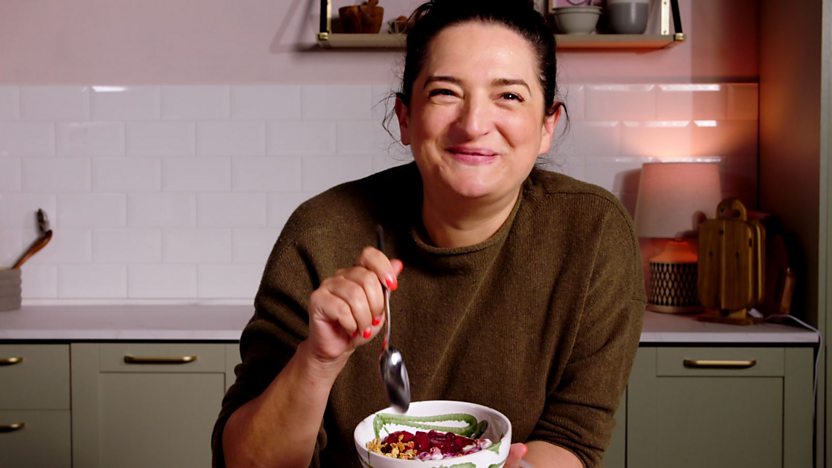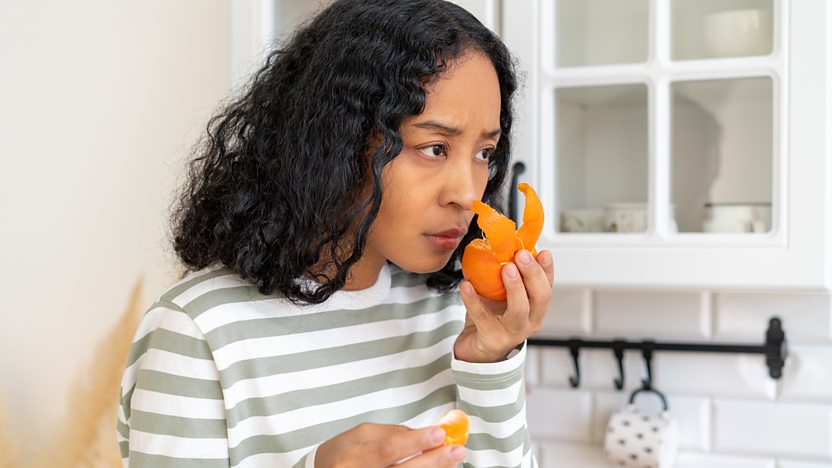The low-maintenance edible garden for lazy gardeners
Let go of digging, fertilising and tidy rows of vegetables. How to do less work and get back to nature with an edible forest garden.
It’s officially flower show season, with one of the biggest, The RHS Chelsea Flower Show returning 22-27 May 2023. Award-winning Bristol-based gardener Steve Williams, an expert on BBC Two's Your Garden Made Perfect, is passionate about turning gardens – big and small – into natural spaces where everything you grow you can eat.
Steve took BBC Food to an edible forest garden to explain how to grow your own without (too much) effort, and how forest gardening differs from your usual veg patches.
Fruit and veg patch vs edible gardens
The end goal is the same: a ready supply of fresh fruit, herbs and vegetables in the kitchen. However, an allotment or veg patch often involves cultivating the land to suit the plants, and growing annuals that must be replaced each year. The space is kept clear of other plants (weeds) and plants tend to be ordered in tidy rows. Edible forest gardens are less hands-on. You establish what your space is suited for (see below for how to do this) and plant perennials, which will keep growing year after year. Then just let nature take its course.
“I think what’s so accessible about this style, is that with a traditional fruit and veg garden, you have a crop rotation and you keep it all very clean... it makes you feel you need to know a lot. There’s a lot of digging and a lot of effort. With this, you plant it and you steward it - you're an editor more than a gardener.”
Depending on the size of your garden, you don’t have to necessarily choose between the two styles. As we walk around the edible forest garden Steve points out a traditional raised bed full of vegetables: “You could have a raised bed to experiment with, but why not have the rest of it as an edible garden?”
While edible gardens are likely to include well-known herbs, fruits and veg they also include ‘edimentals’. “Stephen Barstow, came up with this word and it’s essentially plants that are edible but also look good. By that definition, that can be anything,” Steve says, pointing out, "That's an artichoke and it's going to get massive with a really lovely flower on it."
As we move on to herbs, Steve spots chives. "They have purple, or white flowers, so while they are amazing for salads, you can also just be growing them as an ornamental plant." Alliums are good-lookers and will often self-seed (like chives) or even resprout underground year after year. Steve picks out babington's leek: a garlicky-flavoured onion, ready to harvest in winter or spring, that grows back from its bulb after harvesting. Reaching up to 2 meters in height, its weird and beautiful purple flowers add visual interest as well as food for bees.
“If you have a perennial allium, you can just keep harvesting the leaves of that flower constantly.” If it's a sunny spot, then go for something like elephant garlic which Steve describes as having "big tubers" which are ripe for picking.
“We can choose plants that work in a system which creates a very self-sustaining, low maintenance space – whether it’s a balcony or a big garden.”
Edible gardens are based on ‘forest gardening’
To get the most out of your edible forest garden, if space allows, Steve recommends the seven-tier system laid out by the forest gardening model. This was created in the 1980s by Robert Hart. The system involves:
Canopy layer – over-arching fruit trees
Low-tree layer – smaller nut and fruit trees that sit under the canopy
Shrub layer – often berries and currants
Herbaceous layer – leafy vegetables and herbs
Underground layer – plants which have edible roots and tubers
Ground cover layer – horizontally spreading low plants that fill in the gaps
Vertical layer – vines and climbers
“Nature is always trying to get back to a forest… So, let's look at nature for inspiration,” says Steve. If space doesn’t allow for all seven layers, just go for three that will fit. A low-tree layer may be one crab apple or morello cherry tree, both of which are tough, can be kept small and don't mind a little shade.
“Not only are things edible in a food forest but you're embracing seasonal change. So, with the low-tree layer, in spring you get blossom. Cherry trees, apple trees, plum trees… You could describe those as edimentals. This is sea buckthorn – it's great for vitamin c, and great in cocktails – it’s a great low-tree layer!”
To make it a success, you’re probably going to need to have a good, few years for everything to become established. This doesn’t mean you won’t have produce to consume during that period, but it will take time to grow into full production.
Related articles
How to start
The first thing you need to do is to ask yourself:
- What type of soil do I have?
- Does it get much sun?
- How much space do I have?
- What’s pre-existing (trees/plants etc)?
The answers to these key points will help you choose the plants which will be self-sustaining.
“If you’ve got quite shady gardens, it doesn't mean you can't grow anything. Think about forests, you have lots growing under the shade of trees, and perennials – especially herbs – are great for that." Hardy herbs like the celery-esque lovage is a good option as is lemony sorrel. A good ground cover for a shady area are Nepalese raspberries, says Steve, adding "they ramble all over the place!"
“If you have free-draining, quite poor soil, that’s great for Mediterranean herbs like fennel and things that just grow wild in very harsh environments. You could have a herbaceous layer of things like melissa (lemon balm) and different mints.”
“If you’ve got a boggy garden and you think 'I can't grow anything', well actually that’s an opportunity! If you have a constraint, it means you'll be creative with your design, so things like common valerian will grow well in that.” Steve also points to wild angelica as another example which grows well in damp conditions. "It's considered a British weed but the stem and leaf stalks can be candied and used to make cake decorations. The aromatic seeds are used in flavouring and the young leaves can also be used as a vegetable [if boiled]."
There are of course plants which are good for pretty much all conditions. Rosemary can be quick to establish and is very hardy. If you're looking for a fruit that requires just a tiny bit of pruning once a year, and possibly a bit of water if it's a dry summer, then gooseberries are a good bet. Redcurrants and raspberries also will tolerate a bit of shade and require very little input, especially in heavier soils.
There are excellent forest garden books and blogs where gardeners will share their experiences of lesser-known perennials, and how to match them to your particular space.
Choosing the right plants
The key is to not fight the natural conditions. “If you're having to go to the lengths of fertilising and replenishing the soil, it means you're working against the environment. The aim is that in future, it will be low maintenance, so keep that in mind when you’re deciding what to grow.”
Another way to make it low maintenance is to put in plants that will supress weed invasion. “Thyme makes for a great ground cover. By using native plants like these, you’ll naturally limit other weeds that you don't want – and that's how it becomes self-sustaining.”
Steve also points to wild strawberries as a good option with there being different breeds to suit different conditions, for example woodland strawberries enjoy shady and moist conditions. “They'll take up a lot of the soil space where weeds would get in, but they also fruit.
“For your beneath ground layer that's where you'd have all your root vegetables. Which you probably will harvest. This is your opportunity to merge both traditional fruit and veg gardens with forest gardens – think carrots, skirret and parsnips.”
How to create an edible garden with a very small space
If you have an outside space but it’s small, Steve suggests making the most of walls and fences. “Think vertically. You could have a small apple tree or vines, which if pruned and clipped, could be trained along a wall while giving you loads of produce.”
If you’ve got a balcony then Steve suggests going for pots or installing a ‘green wall’ but with both, you’ll need to make sure you water them regularly as that’s what frequently causes them to fail.
“They are great to experiment with though – things like strawberries or leafy greens could work really well. Alternatively, if you’re on a sunny balcony or you have a window box go for a Mediterranean herb garden. They require less watering.”
How to save money
In the long-term, a forest garden should be cheaper – as you’re not having to regularly re-plant seeds/plants. And if you choose carefully you’re not having to pay out on regularly watering (with the exception of green walls, in which case Steve suggests you save water you’d otherwise be throwing down the sink).
However, there is an outlay cost, Steve suggests buying plants which are small rather than large, though this does mean it will take longer to establish. But Steve points out you should look at the bigger picture – that a bit of work now means far less effort in the future.
Steve also suggests, looking around to buy your plants, whether that's going to the supermarket to get seeds or plants, checking online retailers or having a thorough look around at garden centres. “It might be a case of looking at the wild flowers section and looking up what’s edible rather than going to the traditional edible section in the garden centre – the wild flowers could be cheaper and actually hardier.”
Originally published April 2022






